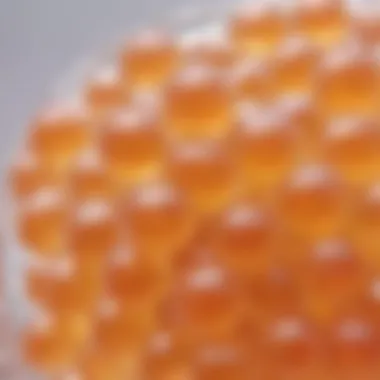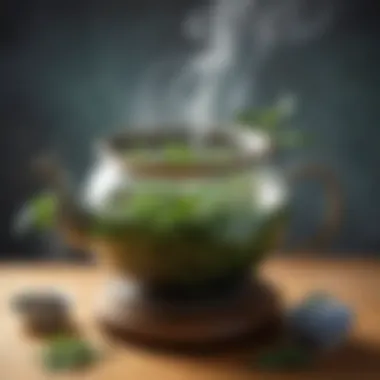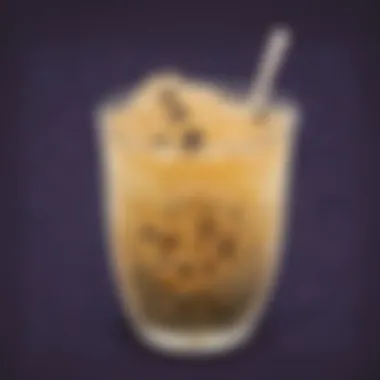Master the Art of Crafting Boba: A Comprehensive Guide to Homemade Bubble Tea


Science Fun Facts
Boba, also known as bubble tea, originated in Taiwan in the 1980s. Contrary to what some may think, the 'bubbles' in bubble tea actually refer to the frothy bubbles formed when the drink is shaken or blended, not the tapioca pearls.
Discover the Wonders of Science
Boba-making is a fascinating blend of culinary arts and chemistry. The transformation of dry tapioca pearls into chewy, sweet bubble tea delights involves the scientific concepts of gelatinization and caramelization. Through this process, the tapioca pearls absorb flavor and become the signature boba treat.
Science Experiment Showcase
Conducting a boba experiment at home can be an exciting learning opportunity for kids and adults alike. By following a simple recipe, gathering the necessary materials such as tapioca pearls, tea leaves, and sugar, and taking safety precautions while cooking, you can observe firsthand how small tapioca pearls can turn into delightful, chewy balls in a sweet drink.
Introduction to Boba
In the vast world of beverages, boba holds a unique place, captivating the taste buds of many with its intriguing combination of flavors and textures. Introducing newcomers to this delightful concoction is akin to unveiling a treasure trove of sensory experiences. As we delve into the realm of boba, we embark on a journey filled with possibilities, where creativity and tradition intertwine to create a beverage that transcends mere refreshment. This article serves as a guiding light for boba enthusiasts, illuminating the path towards mastering the art of crafting this beloved drink within the comfort of one's home.
What is Boba?
Boba, also known as bubble tea, originates from Taiwan and has transcended borders to become a global sensation. At its core, boba is a beverage that combines tea, usually in the form of a sweet and aromatic base, with chewy tapioca pearls. These pearls, derived from cassava root starch, provide a distinct mouthfeel, setting boba apart from conventional teas and coffees. The marriage of these two elements results in a drink that offers a delightful contrast of flavors and textures, creating a harmonious symphony for the palate to savor.
Popularity of Boba
The rise of boba's popularity can be attributed to its versatile nature and ability to cater to diverse preferences. With a multitude of tea bases, ranging from classic black tea to exotic fruit infusions, boba presents a myriad of options for enthusiasts to explore. Additionally, the customizable nature of boba allows individuals to adjust sweetness levels, ice content, and toppings according to their liking. This adaptability has enabled boba to carve a niche in the hearts of beverage enthusiasts worldwide, transcending cultural boundaries and appealing to a broad demographic.
Ingredients and Equipment


In this comprehensive guide on making boba, the section of Ingredients and Equipment plays a crucial role in the boba-making process. Having the right ingredients and equipment is essential to ensure the quality and taste of the final product. Tapioca pearls, tea base, sweeteners, and specific equipment like a pot, strainer, and tapioca pearl cooker are all fundamental components in creating the perfect boba. Each ingredient and piece of equipment brings a unique element to the table, contributing to the overall texture, flavor, and experience of the boba drink.
Tapioca Pearls
Brands of Tapioca Pearls
When it comes to choosing the right brand of tapioca pearls, it is crucial to consider the quality and consistency of the pearls. Different brands offer variations in terms of texture, cooking time, and flavor. For instance, some brands may provide pearls that are chewier or have a more prominent sweet potato flavor. Exploring different brands allows boba enthusiasts to find their preferred taste and texture, enhancing their overall boba-making experience.
Cooking Instructions for Tapioca Pearls
Understanding the cooking instructions for tapioca pearls is essential to achieve the perfect consistency and flavor. Each brand may have specific instructions regarding cooking time, water-to-pearl ratio, and cooling methods. Following these instructions precisely can guarantee that the tapioca pearls are cooked to the desired texture and taste. Overcooking or undercooking the pearls can significantly impact the final boba drink, making it crucial to adhere diligently to the cooking guidelines.
Tea Base
Types of Tea
The type of tea used as the base for boba plays a significant role in the overall flavor profile of the drink. Popular options include black tea, green tea, oolong tea, and herbal teas. Each type of tea offers its unique aroma and taste, which can complement the sweetness of the tapioca pearls. Experimenting with different tea types allows boba enthusiasts to create diverse flavor combinations, catering to their preferences and expanding their boba-making repertoire.
Brewing Techniques
Mastering the art of brewing tea is essential for achieving a balanced and flavorful tea base for boba. Factors such as water temperature, steeping time, and tea-to-water ratio can influence the strength and taste of the brewed tea. Various brewing techniques, like gongfu cha or Western-style brewing, offer different experiences in terms of flavor concentration and complexity. Choosing the right brewing technique based on personal preferences can elevate the overall boba-drinking experience.
Sweeteners
Sweeteners add a touch of sweetness to boba drinks, enhancing the overall taste and balancing the flavor profile. Common sweeteners include simple syrups, honey, or flavored sugar. Selecting the right sweetener can depend on personal preference and desired sweetness levels. Understanding how different sweeteners interact with the tea and tapioca pearls is essential for adjusting the sweetness to suit individual tastes, ensuring a customized boba experience.
Equipment Needed


Pot
A pot is an essential piece of equipment for cooking tapioca pearls and brewing tea. Choosing a pot with a suitable size and material is critical for efficient cooking and heat distribution. Additionally, pots with heat-resistant handles and lids can enhance safety and convenience during the boba-making process. Selecting the right pot ensures that the preparation of tapioca pearls and tea is seamless and allows for precise temperature control.
Strainer
A strainer is a necessary tool for separating the cooked tapioca pearls from the boiling water and rinsing them to achieve the desired texture. Opting for a fine-mesh strainer helps in removing excess starch and maintaining the integrity of the pearls. Using a strainer with the right size and durability simplifies the process of handling hot tapioca pearls and ensures consistent results when preparing boba drinks.
Tapioca Pearl Cooker
A tapioca pearl cooker is a specialized appliance designed for cooking tapioca pearls efficiently and evenly. These cookers come with preset cooking functions that control temperature and cooking time, ensuring consistent results with every batch. Additionally, tapioca pearl cookers may have features like timers and adjustable heat settings to customize the cooking process to individual preferences. Investing in a tapioca pearl cooker can streamline the boba-making process and guarantee perfectly cooked pearls for delicious homemade boba drinks.
Preparing Tapioca Pearls
In the realm of crafting the perfect boba beverage, the preparation of tapioca pearls holds a crucial role. Tapioca pearls, also known as bubbles or boba, are the chewy delights that set bubble tea apart. These little spheres undergo a fascinating transformation process to achieve their characteristic consistency. To commence the journey of creating boba at home, mastering the art of preparing tapioca pearls is paramount.
Key points to consider when preparing tapioca pearls include the quality of the pearls themselves. Opting for high-quality tapioca pearls ensures a satisfying chewiness and flavor. The cooking process is precision-demanding, requiring attentiveness to achieve the ideal texture without under- or overcooking. Additionally, the rinsing step post-boiling is critical to remove excess starch and prevent clumping, ensuring a seamless integration with the other components of the beverage.
The benefits of diligent preparation of tapioca pearls are substantial. By cooking them to perfection, you guarantee a delightful bubble tea experience with the optimal mouthfeel. Moreover, a well-prepared tapioca pearl enhances the overall visual appeal of the beverage, contributing to its aesthetic charm. Attention to detail in this stage paves the way for a truly indulgent and authentic boba treat.
Boiling the Pearls
Boiling tapioca pearls is a precise culinary task that marks the beginning of their transformation into the iconic boba pearls. The pearls, when introduced to boiling water, undergo a mesmerizing metamorphosis, transitioning from opaque spheres to translucent, delightfully chewy bubbles. The boiling process ensures the pearls achieve the desired consistency, striking a balance between tenderness and elasticity.
To boil tapioca pearls effectively, it is crucial to maintain a gentle rolling boil to prevent them from sticking together. Stirring intermittently aids in even cooking and prevents any potential sticking to the cooking vessel. Timing is key in this stage, as overcooking can lead to mushy pearls while undercooking results in unpleasant hardness.


Achieving the perfect boil sets the foundation for a successful boba-making endeavor. The boiled pearls, when executed with finesse, promise a textural delight that harmonizes beautifully with the other elements of the bubble tea, elevating the overall sensory experience.
Rinsing and Sweetening
Upon achieving the ideal softness and chewiness through boiling, the tapioca pearls transition to the rinsing and sweetening phase. Rinsing the pearls under cold water serves multiple purposes - it cools down the pearls, halts the cooking process, and removes excess starch that may lead to clumping. Additionally, this step enhances the pearls' chewy texture and prevents undesired stickiness.
Sweetening the tapioca pearls involves infusing them with a sweet syrup or sugar solution, imbuing them with a subtle sweetness that complements the overall beverage. The sweetening process is a delicate balance; too much sugar can overpower the boba's natural flavor, while too little may result in blandness. Finding the optimal level of sweetness is key to achieving a harmonious boba drink.
Rinsing and sweetening the tapioca pearls with precision sets the stage for a cohesive integration with the tea base and other toppings, culminating in a well-rounded and indulgent boba experience.
Brewing the Tea Base
In the realm of crafting the perfect boba drink, brewing the tea base is a crucial step that significantly impacts the flavor profile and overall experience. The quality of the tea base lays the foundation for a well-balanced and refreshing beverage. By focusing on the tea base, boba enthusiasts can elevate their homemade bubble tea to rival the offerings of professional boba shops.
When delving into the art of brewing the tea base, one must consider the type of tea used, as it serves as the essence of the drink. Factors such as the tea's flavor profile, caffeine content, and aroma play vital roles in enhancing the boba experience. Whether opting for classic black tea for a robust flavor or green tea for a lighter touch, selecting the right tea sets the tone for the entire drink.
Moreover, the brewing process itself contributes to the nuanced flavors of the tea base. From water temperature to steeping duration, each element influences the infusion of flavors from the tea leaves, resulting in a well-rounded and aromatic brew. Finding the ideal balance between strength and subtlety ensures a satisfying sip with every mouthful.
To perfect the tea base, boba enthusiasts may experiment with different brewing techniques to discover the ideal combination that aligns with their taste preferences. Whether cold-brewing for a smoother texture or opting for a traditional hot brew for a bold taste, the versatility of brewing methods allows for a personalized boba experience tailored to individual palates.
Assembling the Boba Drink
In the realm of homemade boba creation, the process of assembling the boba drink holds a paramount significance. This pivotal stage marks the culmination of meticulous preparatory steps of tapioca pearl preparation and tea brewing, converging into the harmonious marriage of flavors and textures that define a quintessential boba beverage. Assembling the boba drink encapsulates the essence of artistry and craftsmanship in bubble tea concoction, embodying a ritualistic blending of elements to achieve the perfect balance of sweetness, richness, and mouthfeel.
Embracing the art of mixing tea and pearls is a nuanced dance of flavors that requires finesse and attention to detail. The careful integration of the freshly brewed tea with the chewy tapioca pearls is a delicate operation that demands precision and timing. Each sip of the boba drink should reflect a harmonious fusion of the robust tea essence and the delectable chewiness of the pearls, creating a sensorial experience that tantalizes the palate and delights the senses.
The addition of sweeteners in the boba drink serves as a crucial aspect in fine-tuning the flavor profile to cater to individual preferences. Whether opting for traditional choices like simple syrup or exploring innovative alternatives like honey or brown sugar, the selection of sweeteners influences the overall taste and enjoyment of the bubble tea. Balancing the sweetness to complement the inherent bitterness of the tea and the neutral taste of the tapioca pearls is a deliberative process that elevates the boba drink to a personalized culinary masterpiece.
Moreover, the realm of adding toppings to the boba drink opens up a realm of creative possibilities to enhance the aesthetic appeal and gastronomic experience of the beverage. From classics like boba pearls and grass jelly to modern renditions featuring fruit jellies and pudding, the choice of toppings adds layers of texture, flavor, and visual intrigue to the concoction. Selecting the right combination of toppings to complement the tea base and pearls requires a discerning eye for flavor pairings and an innovative spirit to push the boundaries of traditional boba creations.
Enjoying Your Homemade Boba
In the realm of \







